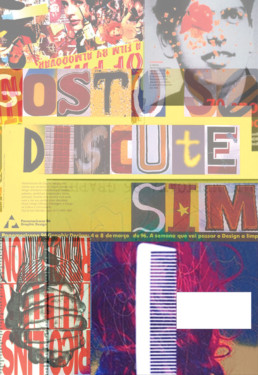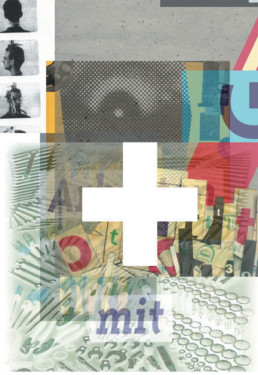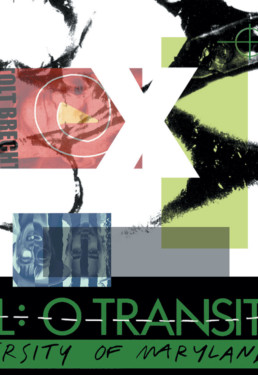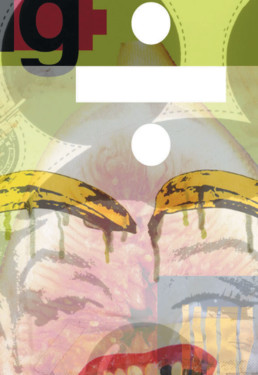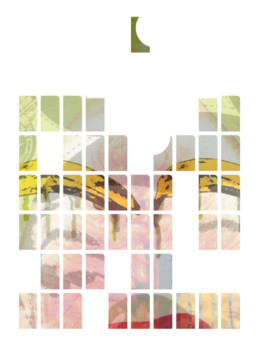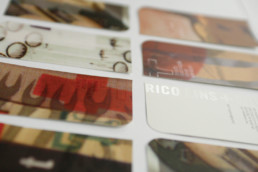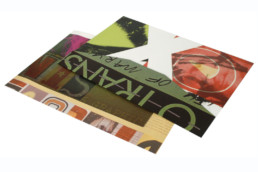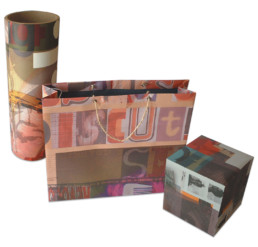Recycling
From the standpoint of creativity, Rico Lins has always been intrigued by the idea of graphic design as “unique work reproduced in series”. This concept points to the central ambiguity of creative graphic design with its ephemerality and an existence limited by its essentially utilitarian condition, reproducible and disposable. On the other hand, it also functions as a permanent thermometer of its time.
Reciclato Project
Posters:
Client: Suzano papel e celulose
São Paulo, 2000
Identity Rico Lins +Studio
Envelopes and business cards:
Client: Rico Lins +Studio
São Paulo, 2000
Somehow this has always been present in Lins’ work in his appropriation of visual clichés, whether icons reclaimed from mass culture, references extracted from works of art or mere reutilization of industrial printed matter. From the Constructivist photo-montages of Rodchenko to the banana pop of Andy Warhol, from Kurt Schwitters to Walt Disney, the contemporary visual universe is that of mass culture and its products: magazine clippings, tickets, money, packaging, political fliers, labels, cheap literature, forms, printed medication information, advertising. The huge resultant production of waste gives rise to the raw materials from which recycled paper is manufactured.
In 2000, when Suzano paper industry invited Lins to participate in the launch event for Reciclato paper, he took “recycling” as his pivotal point with the concept embracing everything from creation to printing to the end uses of paper. As a starting point, he took examples from his work that used images of his own as well as images created by other artists and which were later reutilized in a different context. For the event, he created four projects from the combination of others, altering proportions and colors, recomposing details, superimposing transparencies and, finally, reutilizing photolithographs for re-impressions with varied special colors, varnishes and embossing, with a view to their utilization in the preparation of model packaging and other three-dimensional volumes presented at the event.
In addition to the material produced for the Reciclato launch, Lins also sought to use the opportunity to extend the idea of recycling to the creative process itself and to further reflect on copyright issues, digital reproduction, originality and other themes central to contemporary communications which were – and remain – current. Both the images and the paper on which they are printed coexist in the same industrial waste. Recycling adds, divides, multiplies and subtracts, whether from the viewpoint of social, economic and environmental function, whether from that of marketing strategies. In the midst of these basic arithmetical signs, paper in its raw state can be seen in unprinted surfaces.
Some time later, at the invitation of Nervo Óptico journal, Rico Lins called attention to two other steps in the same process. The first, inward, excavating the more or less accidental authorial genealogy of these images in order to recompose their references and origin. The second, outward, but no less accidental in that this inventory of references, whether casual or explicit, echoed a way of thinking and doing design.
It is natural, then, that these considerations establish a dialogue between the authorial and the commercial in which the individual and the legal entity discover each other looking in the mirror. It is in this space marked by diversity that singularity is revealed: in the visual identity of Rico Lins +Studio and its quest to integrate the random and the systematic, in an elastic gesture that extends from the predictability of a business card to the random unpredictability of a site in permanent construction.
The wide range of choices of graphic material which result from this process has permitted the creation of highly renewable and durable systems that generate impact, curiosity and empathy in the target audience. At the time it was produced, the reutilization of graphic materials was innovative both as process and as creative attitude, instigating thoughtful consideration of visual identity and reclamation of resources. All components were produced from fragments of posters originally created for the launch of the line of paper.
In this way, Rico Lins +Studio proposes, as an alternative to those who believe that nothing more is created, the certainty that everything is transformed.

 Português do Brasil
Português do Brasil